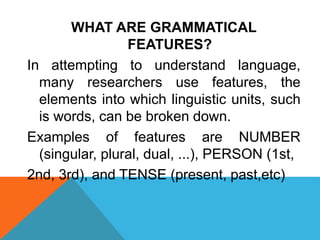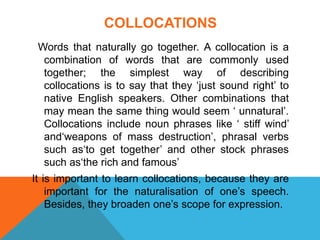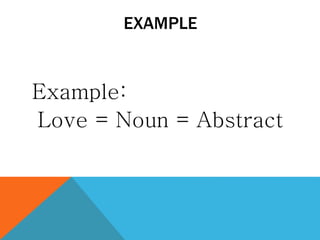Special grammatical feature
- 1. SPECIAL GRAMMATICAL FEATURES Gabriela Garc¨ªa Martha Siza Jessica Duchi Erica Saigua
- 2. WHAT ARE GRAMMATICAL FEATURES? In attempting to understand language, many researchers use features, the elements into which linguistic units, such is words, can be broken down. Examples of features are NUMBER (singular, plural, dual, ...), PERSON (1st, 2nd, 3rd), and TENSE (present, past,etc)
- 3. SPECIAL GRAMMATICAL FEATURE We can teach certain grammatical features to make the meaning clear.
- 4. REGISTER What is appropriate in certain circumstances. Example: I dislike to play basketball. (It is incorrect) I dislike playing basketball.
- 5. COLLOCATIONS Words that naturally go together. A collocation is a combination of words that are commonly used together; the simplest way of describing collocations is to say that they ¡®just sound right¡¯ to native English speakers. Other combinations that may mean the same thing would seem ¡® unnatural¡¯. Collocations include noun phrases like ¡® stiff wind¡¯ and¡®weapons of mass destruction¡¯, phrasal verbs such as¡®to get together¡¯ and other stock phrases such as¡®the rich and famous¡¯ It is important to learn collocations, because they are important for the naturalisation of one¡¯s speech. Besides, they broaden one¡¯s scope for expression.
- 6. EXAMPLES: ? Do me a favour ? Do the cooking ? Have a bath Have a drink ? Break a leg Break a promise
- 7. WORD CLASS Parts of Spech.-Group of words that are used in a certain way. All words belong to categories called word classes (or parts of speech) according to the part they play in a sentence.
- 9. EXAMPLE Example: Love = Noun = Abstract
- 10. Bibliography http://www.englishleap.com/vocabula ry/collocations http://forum.wordreference.com/show thread.php?t=1045017&langid=24 http://www.oxforddictionaries.com/wo rds/word-classes-or-parts-of-speech
- 11. THANK YOU










